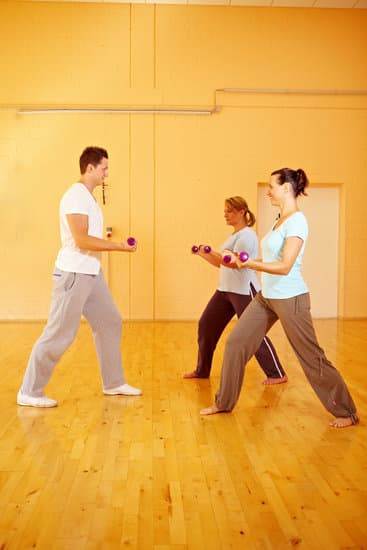How much exercise do you need to get fit? This is a common question for many individuals looking to improve their overall health and fitness. In this article, we will explore the importance of exercise for overall fitness and delve into the various components that contribute to achieving a higher level of physical well-being.
Exercise plays a crucial role in not only maintaining a healthy weight but also in improving cardiovascular health, increasing muscle strength, and enhancing flexibility. Understanding the significance of regular physical activity is essential in creating a successful fitness routine tailored to individual needs and goals.
In the following sections, we will discuss how to set realistic fitness goals, the benefits of both aerobic and strength training exercises, incorporating flexibility and mobility workouts, as well as understanding the recommended amount of exercise for adults based on established guidelines. Additionally, we will provide insights on creating a workout schedule that fits your lifestyle and offer tips for staying consistent and motivated.
Whether you are just starting on your fitness journey or looking to elevate your current routine, this comprehensive guide will provide valuable information on achieving optimal fitness through exercise.
Setting Realistic Fitness Goals
One way to determine your desired level of fitness is by conducting a self-assessment of your current physical condition. This may include evaluating your weight, body measurements, endurance, strength, and flexibility. From there, you can identify areas that need improvement and set realistic goals based on the results you want to achieve. Additionally, considering factors such as age, existing medical conditions, and any physical limitations can help tailor your fitness goals to suit your individual needs.
It’s also important to consider the timeframe within which you want to achieve your fitness goals. Whether it’s weeks or months, setting a realistic timeline can help prevent frustration and disappointment. Gradually increasing the intensity and duration of your workouts can contribute positively towards achieving those objectives.
| Factors to Consider When Setting Fitness Goals | Details |
|---|---|
| Physical Condition | Evaluate weight, measurements, endurance, strength and flexibility |
| Individual Needs | Consider age, medical conditions, and physical limitations |
The Role of Aerobic Exercise in Getting Fit
Aerobic exercise, also known as cardio, plays a crucial role in achieving overall fitness. This type of exercise involves activities that increase your heart rate and breathing, such as running, swimming, cycling, and dancing. Engaging in regular aerobic workouts offers a wide range of benefits for both your physical and mental well-being. These include improved cardiovascular health, increased endurance, better mood and mental clarity, and weight management.
One of the key benefits of aerobic exercise is its ability to improve cardiovascular health. When you engage in activities that raise your heart rate, you strengthen your heart muscle and improve its efficiency. Over time, this can lead to a reduced risk of heart disease, lower blood pressure, and improved circulation. Additionally, aerobic workouts help increase your lung capacity and oxygen flow throughout the body.
Another advantage of incorporating cardio workouts into your fitness routine is increased endurance. Aerobic exercise helps train your body to use oxygen more efficiently, allowing you to sustain physical activity for longer periods. As a result, you may find everyday tasks become easier to perform and recreational activities more enjoyable.
Lastly, engaging in regular aerobic exercise can have a positive impact on your mental well-being. Physical activity triggers the release of endorphins-also known as “feel-good” hormones-in the brain, which can help reduce stress and anxiety levels. In addition to improving mood and mental clarity, cardio workouts have been associated with better sleep quality and overall cognitive function.
| Benefit | Description |
|---|---|
| Improved cardiovascular health | Reduced risk of heart disease, lower blood pressure, improved circulation. |
| Increased endurance | Efficient oxygen use leads to sustained physical activity. |
| Positive impact on mental well-being | Release of endorphins reduces stress and anxiety levels; improves mood and mental clarity; better sleep quality. |
The Importance of Strength Training for Overall Fitness
Strength training is a crucial component of any fitness routine, as it offers numerous health benefits beyond just building muscle. Here are some key points to consider when incorporating strength training into your workout regimen:
- Building lean muscle: Strength training not only helps sculpt and define the body, but it also plays a vital role in boosting metabolism. As muscle tissue requires more calories to maintain than fat tissue, increasing lean muscle mass can help you burn more calories at rest, ultimately supporting weight management and overall health.
- Improving bone density: Engaging in regular strength training can help increase bone density, reducing the risk of osteoporosis and fractures as you age. Weight-bearing exercises such as lifting weights or using resistance bands promote bone health and contribute to overall physical resilience.
- Enhancing functional capacity: Strong muscles contribute to better balance, coordination, and posture, leading to reduced risk of falls and injuries. It also supports everyday activities such as lifting groceries, climbing stairs, or participating in recreational sports with greater ease and efficiency.
Incorporating Flexibility and Mobility Exercises
There are various types of flexibility and mobility exercises that you can incorporate into your fitness regimen. Some popular options include yoga, Pilates, dynamic stretching, and foam rolling. These exercises can help improve muscle flexibility, joint mobility, and overall body awareness. Additionally, they can also help reduce the risk of injury during physical activity by preparing your body for movement.
When it comes to preventing injury, many people tend to focus solely on strength training or cardio workouts. However, neglecting flexibility and mobility exercises can lead to muscle imbalances and decreased range of motion, which may ultimately result in injury. By incorporating these exercises into your routine, you can improve your overall fitness level while reducing the risk of strains or sprains.
To ensure that you are reaping the benefits of flexibility and mobility exercises, it’s important to set aside dedicated time for these activities in your workout schedule. Incorporating these exercises a few times a week will not only enhance your overall performance but also contribute to the longevity of your fitness journey.
Remember that finding the right balance between strength training, cardio workouts, and flexibility/mobility exercises is key to reaching your desired level of fitness while minimizing the risk of injury.
Understanding the Recommended Amount of Exercise for Adults
When it comes to getting fit, understanding the recommended amount of exercise for adults is crucial in reaching your fitness goals. The guidelines provided by health and fitness organizations can serve as a helpful framework for individuals looking to improve their overall fitness level. By following these recommendations, you can create a workout routine that aligns with your personal goals and lifestyle.
The Physical Activity Guidelines for Americans
The Physical Activity Guidelines for Americans, developed by the U.S. Department of Health and Human Services, recommend that adults should aim for at least 150 minutes of moderate-intensity aerobic activity or 75 minutes of vigorous-intensity aerobic activity per week. In addition to aerobic exercise, adults should also engage in muscle-strengthening activities on two or more days per week.
This combination of aerobic and strength-training exercises can help improve cardiovascular health, build muscle strength, and enhance overall physical well-being.
Customizing Your Exercise Routine
While the general recommendations provide a valuable starting point, it’s important to customize your exercise routine based on your individual goals and fitness level. Some individuals may need more than the recommended amount of exercise to achieve specific fitness objectives, while others may require less. Consulting with a fitness professional can help you tailor a workout regimen that suits your needs and capabilities.
By understanding the recommended amount of exercise for adults and how it applies to your personal fitness journey, you can effectively work towards improving your overall health and well-being. Whether you’re aiming to lose weight, build muscle, or simply enhance your physical endurance, incorporating regular exercise into your routine is essential for reaching your fitness goals.
With the right balance of aerobic activity, strength training, flexibility exercises, and mobility work, you can create a comprehensive workout plan that supports your desired level of fitness.
Finding the Right Balance
Assessing Your Time and Commitment
When it comes to creating a workout schedule, it is important to consider your daily commitments, work schedule, and personal obligations. Assessing how much time you have available for exercise will help you determine the frequency and duration of your workouts. Whether you can commit to working out three times a week for an hour or squeezing in shorter workouts more frequently, finding the right balance that fits your lifestyle is key to maintaining consistency.
Choosing Activities You Enjoy
One of the keys to sticking with a workout schedule is choosing activities that you enjoy. Whether it’s dancing, hiking, swimming, or attending group fitness classes, finding activities that bring you joy will make it easier to stay committed to your fitness routine. Experiment with different types of workouts until you find something that resonates with you and makes you look forward to exercising.
Creating Realistic Goals
When planning your workout schedule, it’s essential to set realistic goals that align with your lifestyle and fitness level. Setting unreasonable expectations can lead to frustration and burnout. Instead, focus on gradual progress and celebrate each milestone along the way. By setting achievable goals, you’ll be more likely to stick to your workout schedule and experience success in reaching your desired level of fitness.
By taking these factors into account when creating a workout schedule, you can ensure that your fitness routine complements rather than overwhelms your lifestyle. It’s all about finding the right balance that allows you to prioritize exercise while still enjoying other aspects of life.
Overcoming Common Barriers to Exercise
Finding the motivation to exercise regularly can be challenging, but it is essential for reaching and maintaining your fitness goals. One common barrier to exercise is lack of time. Many people feel overwhelmed with work, family responsibilities, and other obligations, making it difficult to find time for physical activity.
It’s important to prioritize exercise and schedule it into your day just like any other appointment. Whether it’s waking up early to hit the gym, going for a walk during your lunch break, or taking a fitness class after work, finding pockets of time for exercise can make a significant impact on your overall health.
Another barrier to staying consistent with exercise is lack of motivation. It’s normal to experience periods of low motivation, but finding ways to stay inspired can help you push through those tough times. Setting specific, achievable goals can give you something concrete to strive for and track your progress.
Whether it’s running a 5k race, increasing the weight you lift during strength training sessions, or mastering a new yoga pose, having clear goals can keep you focused and motivated. Additionally, finding an exercise buddy or joining a group fitness class can provide accountability and support, making it easier to stick to a regular workout routine.
It’s also common for people to struggle with staying consistent in their exercise routine due to lack of enjoyment in their workouts. Finding an activity that you enjoy not only makes exercising more fun but also increases the likelihood that you will stick with it long term.
Whether it’s dancing, swimming, hiking, or playing team sports, there are endless options for physical activity. Experimenting with different types of exercises can help you discover what brings you joy and keeps you coming back for more.
Seeking Professional Guidance
In conclusion, seeking professional guidance from a personal trainer or fitness coach can be incredibly beneficial in reaching your fitness goals. These professionals are trained to provide personalized workout plans, guidance on proper form and technique, and motivation to keep you on track. They can also help you set realistic goals and monitor your progress, making any necessary adjustments along the way.
Working with a personal trainer or fitness coach also provides an added level of accountability. Knowing that you have scheduled sessions with a professional can help keep you committed to your exercise routine. They can also offer expert advice on nutrition and lifestyle habits to support your overall fitness journey.
Ultimately, whether you are new to exercise or looking to take your workouts to the next level, enlisting the help of a professional can make a significant difference in your fitness journey. Their expertise and guidance can help ensure that you are getting the most out of your workouts while minimizing the risk of injury.
So, if you’re serious about getting fit, consider investing in the support and expertise of a personal trainer or fitness coach to help you reach your full potential.
Frequently Asked Questions
How Long Does It Realistically Take to Get Fit?
The time it takes to get fit realistically varies from person to person and depends on several factors such as starting fitness level, consistency of training, diet, and overall lifestyle. Generally, it can take anywhere from a few weeks to a few months to start seeing noticeable improvements in fitness levels.
However, significant transformations may take several months to a year or longer.
Is 30 Days Enough to Get Fit?
Whether 30 days is enough to get fit largely depends on individual goals and starting point. While 30 days can kickstart a fitness journey or lead to some improvements in strength and endurance, it may not be enough time for substantial changes in body composition or significant increases in overall fitness levels.
Consistency with exercise and nutrition beyond the initial 30 days will be crucial for long-term results.
Is 2 Hours of Exercise a Day Too Much?
Two hours of exercise a day can be quite intense for many people and may not be sustainable in the long run, especially if not spaced out properly or if the body is not given enough time to rest and recover. It’s important to listen to the body’s signals of fatigue and avoid overtraining, which can lead to injuries or burnout.
For most individuals, aiming for around 30-60 minutes of moderate to vigorous exercise most days of the week is a more manageable goal to maintain consistently over time.

Passionate about providing useful information to anyone with an interest in the field of Personal Training, I strive to pass on to our readers quality information and to answer any questions about Personal Trainers, the work they do and how to become one.





